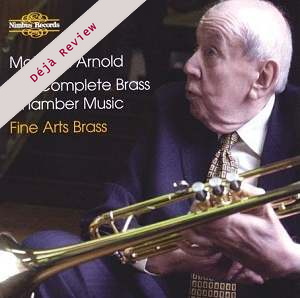
Déjà Review: this review was first published in June 2007 and the recording is still available.
Sir Malcolm Arnold (1921-2006)
The Complete Brass Chamber Music
Fine Arts Brass Quintet
rec. 2006, Wyastone Leys, Monmouth, UK
Nimbus Records NI 5804 [79]
Nimbus Records bring us an exciting, newly-recorded collection of Sir Malcolm Arnold’s brass chamber music, compositions ranging from 1961 to 1987. It is entitled the “Complete Brass Chamber Music”, which isn’t entirely accurate, considering that Conifer released “Music For Brass” years ago with the Grimethorpe Colliery Brass Band (recently re-issued on Decca 476 5348, UK only.), with many different pieces, most notably the “Fantasy for Brass, op. 114”. This new release makes a nice companion to that highly recommended set.
The liner-notes make no mention of Sir Malcolm’s passing, so I can only assume that this disc was stuck in production when he died and has only been released recently.
The composer did know about these recordings and writes the following note in the booklet:
“In 1987 I wrote my Quintet for Brass No 2 for the Fine Arts Brass Ensemble. I am absolutely delighted therefore that this fine group of musicians have now recorded this piece, along with many of my other works for brass ensemble, for the Nimbus label. The artistry and commitment that this group bring to their performances is truly exceptional.
Sir Malcolm Arnold, – August 2006.”
Fanfare for Louis was written for the legendary jazz trumpeter, Louis Armstrong, for Armstrong’s 70th birthday in 1970; he passed away one year later. Not surprisingly, there is a very jazzy feel to this piece. It is interesting to note that when Arnold attended the Royal College of Music, he dropped out after only two years stating ‘they didn’t teach you to play like Louis there’. It is interesting that he eventually became a classical and film composer, was trumpet section-leader of the London Philharmonic, and never opted to follow Armstrong’s steps into the jazz world.
The Brass Quintet No. 1 was previously recorded by Fine Arts Brass in the vinyl LP era, but has never been released on disc. It was written for the New York Brass Quintet, but the competition on disc is from the Philip Jones Brass Ensemble recorded for Decca in the 1970s. That recording is very good, but it is very nice to have this piece in a modern digital recording. The second movement is very dark and brings to mind some of Arnold’s later symphonies. The third movement returns to the upbeat nature of the first, with some very fun duelling trumpet melodies over the top of the lower brass.
The Nimbus producers have wisely interspersed Arnold’s fantasies between the larger pieces. Richard Sandland’s and Simon Lenton’s notes sum it up best: “Single-line music is often difficult to listen to, at the worst, one can feel like an intruder on private, practice time.” Arnold wrote fantasies for every orchestral instrument there is, though this collection limits it to the four brass instruments. His woodwind fantasies can be found on one of Hyperion’s Chamber Music of Sir Malcolm Arnold, available on budget price Helios.
The Little Suites have been transcribed for brass quintet by trumpeter Simon Lenton. The first and second have been recorded elsewhere, but the Little Suite No. 3 has not. They are all nice, but tend to sound rather similar and perhaps would be preferred in their orchestral or wind band arrangements.
The most exciting piece for Arnold collectors would have to be the Brass Quintet No. 2. “Why write No. 1 again?” the composer said. It is only half the length of the former, though the second movement does sound a bit similar in form to that of the second movement from Quintet No. 1. The third movement brings to mind a bit of the composer’s Irish Dances.
The longest piece recorded here is Malcolm Arnold’s Symphony for Brass, also recorded on Decca by the PJBE for whom it was written. Like Quintet No. 1, the PJBE’s analogue recording is very good, but it is nice to get a brand new digital recording. The FAB has an increased trumpet and trombone section which gives the symphony “more punch” compared to the other pieces throughout this disc. The third movement is especially brooding. Composed during a time when the composer was depressed, this is about as far from the happy, upbeat nature of the Fanfare for Louis as one can get.
This disc is filled to the brim – at just under 80 minutes – with a wide range of genres of brass music and can be easily recommended to any fan of brass music.
Thomas Pridonoff
Buying this recording via a link below generates revenue for MWI, which helps the site remain free.


Contents
Fanfare for Louis (1970)
Brass Quintet No. 1, Op. 73 (1961)
Fantasy for B flat Trumpet, Op. 100 (1969)
Little Suite for Brass No. 1, Op. 80 (1963)
Fantasy for Horn, Op. 88 (1967)
Little Suite for Brass No. 2, Op. 93 (1967)
Fantasy for Trombone, Op. 101 (1969)
Little Suite for Brass No. 3, Op. 131 (1987)
Fantasy for Tuba, Op. 102 (1969)
Brass Quintet No. 2, Op. 132 (1987)
Symphony for Brass, Op. 123 (1978)

















